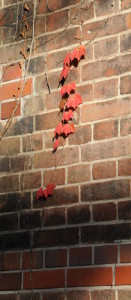When you start living in Japan, sooner or later you will start talking to some Japanese about your own country and how it is different from Japan. And then, the topic of the seasons will come up, and your friend will say something like: “You know, in Japan, we have four seasons!” with a gleam of pride in her eyes, as if the concept of four distinct seasons is something no gaijin has ever heard of. However, said gleam will immediately turn to bitter disappointment upon your answer: “So do we. So what?”
I think I finally figured out what they really mean with that. it’s not the fact that there are four distinct seasons at all, the Japanese are well aware that other countries have those too. Also, it is easy to diagnose summer when it has 35 degrees outside, or to declare winter when you’re suffering from frost bite. I think what they mean is that the change of seasons is obvious, irreversible, and swift. Sometimes the change of season is so abrupt, it happens over night.
 For example, it is already autumn here. It started about 2.5 weeks ago. How I know? Well, it has cooled down, even though we still have more than 30 degrees. There are also more rainy days, but that’s not it either. The two things that made me sigh with relief: Humidity has dropped considerably, from one day to the next. Now I have to actually move to start sweating, in summer this is not necessary. Also, most of the cicadas that make summer so noisy, have died. There are still some around, but there are much fewer individual insects, and those are different species since their call has changed.
For example, it is already autumn here. It started about 2.5 weeks ago. How I know? Well, it has cooled down, even though we still have more than 30 degrees. There are also more rainy days, but that’s not it either. The two things that made me sigh with relief: Humidity has dropped considerably, from one day to the next. Now I have to actually move to start sweating, in summer this is not necessary. Also, most of the cicadas that make summer so noisy, have died. There are still some around, but there are much fewer individual insects, and those are different species since their call has changed.
Thinking about it a bit more, I now believe that all the four seasons in Japan have a rather distinct point as to when they begin. And most of those points are not related to any fixed day, obviously, but to some event in nature. That’s probably the reason why the Japanese love any kind of nature viewing so much: They know the cherry blossoms mark the height of spring, and that when the momiji colors are over, winter will come. It’s also easy to notice these things when you’re living in a wooden house with hardly any insulation, as most of the old Japanese did, and many still do.
Anyway, let me list the things that mark the new seasons in Japan. Feel free to comment if you think I’m wrong, after all, this is just my theory.
Spring starts with the ume (peach blossoms). It is still cold then, and it may still snow, but once the red peach blossoms can be seen, they mark the end of winter. The height of spring has been reached during hanami – cherry blossom viewing. And once the last cherries have lost their blossoms and put on their green leaves, it will only take a week or two more to arrive at Summer.
Summer begins some time in May when the temperature rises further, but even more so, humidity. Early summer comes with tsuyu, the rainy season, and the rain does not ease the humidity, on the contrary! When you can’t seem to stop sweating, no matter what you do (or not do), that’s summer. At some point the cicadas will start their noisy song, marking midsummer.
Autumn, as I said above, will start with a sharp drop in humidity, usually at the end of August. The cicadas drop from their trees as well, and you can enjoy silent nights of sleep again. The most beautiful part of autumn is the koyo, when the leaves of the maple trees turn red, orange, or yellow. That does not happen until the night temperature falls below a certain threshold, but from then on, the momiji can be admired for two or three weeks. Once their leaves fall to the ground as well, some time at the end of November, that’s the end of the season.
Winter starts a week or two after the koyo, again with a drop in temperature. It may not snow everywhere (it doesn’t in Kyoto), and the temperature will hover just above zero degrees. It will be quite dry though, and especially clear days will be wonderful to go out and climb up somewhere and have a look over the country.
That’s my theory. Autumn was obvious this year, I will try to see if I can notice a similar swift change for winter. This whole year has been usually cool, I just hope we will not get an early and too cold winter this time…

Don’t we have similar things in Austria?
Spring: Schneeglöckchen or maybe Bärlauch?
Summer: Marillen?
Autumn: Sturm?
Winter: Weihnachtsmärkte?
I thought you were serious until I read “Weihnachtsmärkte” 😛 By now, they are starting in October already, right? Just like the Lebkuchen sale…